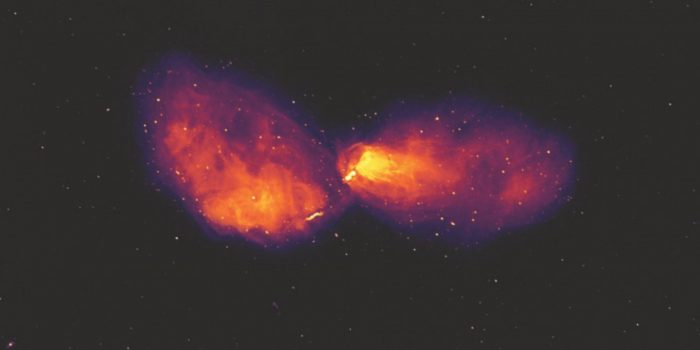Recently, a study has been published in the journal Nature Astronomy that states that astronomers have captured a most unsettling image of radio emissions from the closest actively feeding supermassive black holes to our planet.
The large eruption of the supermassive black hole has a width of 16 full moons.
The image shows radio emissions of large amounts of material ejected from the black hole at speeds approaching that of light, with gigantic balls of plasma stretching out more than one million light-years from the center of its home galaxy, Centaurus A.
This galaxy is around 12 million light-years from our world and is the fifth-brightest galaxy in the observable sky. In the center of this galaxy is a black hole that is feeding with its force of 55 million suns. This hole swallows gas, dust, and other materials stuck in space.
The galaxy surrounding the black hole is just a tiny patch at the center of the image, and the dots lighting the backdrop are other similar galaxies. The astronomers made use of the Murchison Widefield Array (MWA) telescope to get the images. It was located in Western Australia. It also includes X-ray and optical observations, said Astronomer Benjamin McKinley of Curtin University in Australia, who’s also the lead author of the recent study.
Radio plasma can be seen in blue-emitting from the black hole in the image, and it seems to be interacting with very hot gas that’s emitting X-rays in orange, with cold neutral hydrogen apparent in a purple that appears ominous. The red shows H-alpha spectral lines that can be seen when hydrogen loses electrons.
“Previous radio observations could not handle the extreme brightness of the jets and details of the larger area surrounding the galaxy were distorted, but our new image overcomes these limitations,” added McKinley, in the same statement.

It was also found out that the core was brightest in the middle with the most active energy. Massimo Gaspari, an astrophysicist from Italy’s National Institute for Astrophysics, said that these images have added to the theory of “chaotic cold accretion” (CCA).”
“In this model, clouds of cold gas condense in the galactic halo and rain down onto the central regions, feeding the supermassive black hole,” said Gaspari, in the statement.
“Triggered by this rain, the black hole vigorously reacts by launching energy back via radio jets that inflate the spectacular lobes we see in the MWA image. This study is one of the first to probe in such detail the multiphase CCA ‘weather’ over the full range of scales.”


